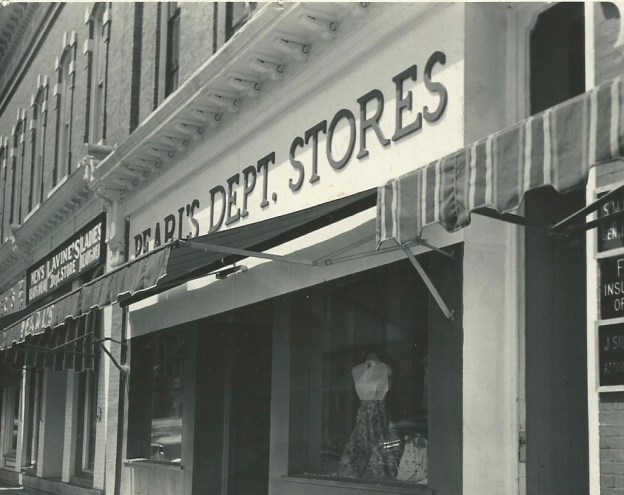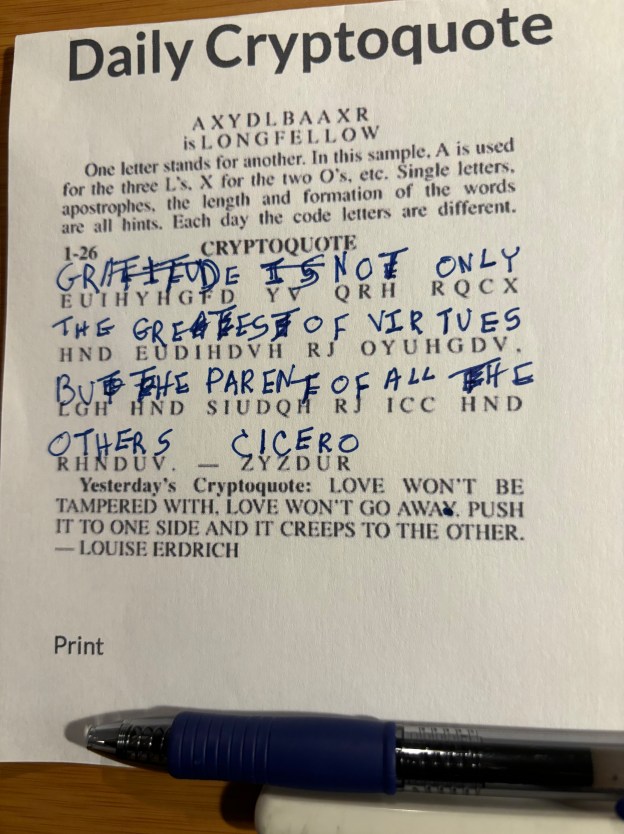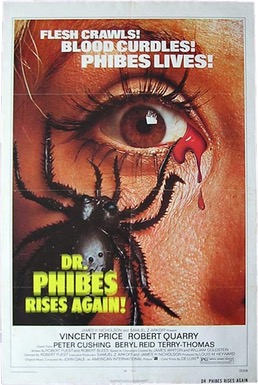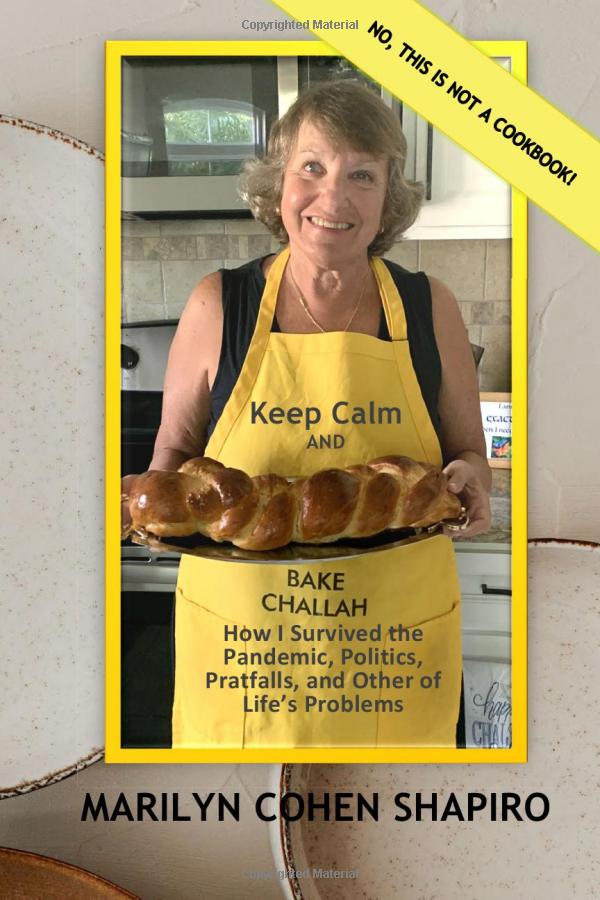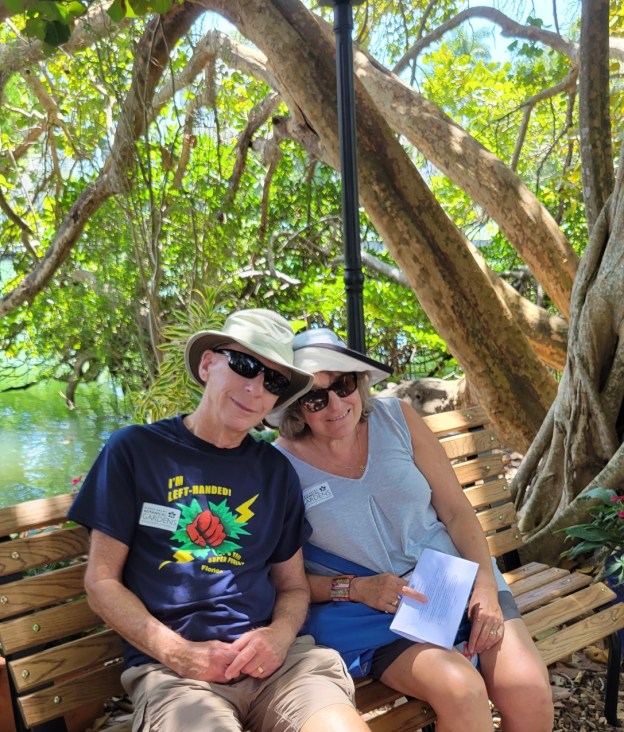Hello. My name is Marilyn, and I am a Cryptoquote addict. The addiction actually snuck up on me.
For years I had done the daily crossword puzzle in Schenectady, New York’s, Daily Gazette,when I got to it before Larry. An English major in college and a reading and writing teacher as an adult, I have enjoyed a sense of satisfaction and contentment to find the exact word to fit into the correct boxes.
Crossword puzzles, however, had never become addictive. I have never dwelled upon the fact that I don’t know a Stanley Donen movie (“Deep in My Heart”), a phrase for being stuck (in a rut), a six-letter word for crown (diadem) or the 1967 and 1968 Super Bowl MVP (Starr). I am not ashamed of resorting to online crossword puzzle solvers if I can’t figure it out. I defer to Larry for most sports questions, as he defers to me for arts and literature. I have even quit and tossed them, unfinished, into the recycling bin.
But Cryptoquotes were/are different. After years of seeing Larry’s handwriting in black felt tip pen under the AXYDLBAAXR is LONGFELLOW hint, I decided around 1992 to find out the attraction of decoding a nonsensical jumble of letters into a meaningful statement. It was love at first attempt.
Not only did it satisfy the reading teacher in me (recognizing those two-and three-letter consonant blends such as “th,” “sh,” and “ght” often unlocked the puzzle), but I also was intrigued by the messages that the Cryptoquote revealed. Some needed explanation—Who is Morpheus, and why should I care about his hand?— but others were humorous or prophetic enough to type into my Favorite Quotes journal I keep on my computer.
Larry graciously gave me full right to the Gazette until our move. As our Orlando paper doesn’t carry it, my dear husband found an on-line source that he prints out for me daily.
Unlike many crypto puzzles whose solutions are puns or, for me, just too simple, the King Features Syndicate Cryptoquote finds sometimes lengthy quotes from notable people, many whom I admire. I solved the following only two days after Ruth Bader Ginsberg’s death on September 18, 2020: “My mother told me to be a lady. and for her, that meant be your own person, be independent.” Other solutions offered me insights that I continue to carry with me. Since decrypting Plato’s words, “Wise men talk because they have something to say; fools talk because they have to say something,” I have often thought twice before blurting out something just to fill the void.
For twenty-two years I have been given words of wisdom —and some laughs—from individuals ranging from Abraham to Zachariah, from Chaucer to Cookie Monster, and from Shakespeare to Shakira, as well as the prolific Anonymous and Source Unknown.
Larry and I have a routine. Sitting next to each other on the couch in the den, Larry hands me one of the two crossword puzzles he has printed out that morning. Sometimes we each finish it alone; other times, one of us asks, “Do you want to start working on it together?”
The minute I am finished—or have given up—I immediately dive into my Cryptoquote. Most of the time, I work through it quickly. There are nights when I don’t go to bed until I can figure it out. When I get desperate, I ask Larry for a hint. (“Is the third letter in the first word an ‘e’?). He consults the online solution and provides the clue.
And, yes, there are days that I cannot solve it. The next day, I usually have to kick myself for missing the obvious. Not figuring out the words Merry Christmas in a holiday greeting from “Your Cryptoquote Friends” on a December 24th puzzle embarrassed me as did not realizing the author was the Notorious RBG herself. I have worked on those with whom I cannot easily break the code on long car rides, in doctors’ offices and, admittedly, boring group ZOOM calls.
I knew I was truly addicted when, two years into my doing the puzzle, the Cryptoquote was not in its usual page in the Gazette. I began flipping rapidly through the classifieds and then through the entire D Section. Nothing. Frantically, I began searching through the entire paper, thinking . . . hoping . . . that maybe the powers that be had decided to move the heart of the paper to a more prominent section. On the Op-Ed page? Next to Ann Landers? In the obituaries?
“Larry,” I yelled to my husband. “I can’t find the Cryptoquote.”
“Are you sure?” he asked. He began a search, calmer, less hurried, but no more fruitful.
Not fooling around, I called the paper. to the source. Hi,” I said to the Gazette operator. “I don’t know if you guys are aware of this, but . . . The Cryptoquote is missing!”
On the other end of the line, there was a brief moment of silence. Then a tired voice said, “Yes, we are aware of the situation. We will publish two Cryptoquotes tomorrow, unless you want to come to Maxon Road for a copy today.”
I quickly calculated the time it would take for the round trip to Schenectady. Forty minutes; with GE traffic, maybe an hour. I declined the offer. I can wait until tomorrow, I thought. It will be hard, but I can wait.
There was something in the operator’s tone, however, that made me quickly realize that I was not the first to call.
“Have you gotten other complaints?” I asked.
“Dozens” she said wearily. “The phone began ringing off the hook at 6:30 a.m. and hasn’t stopped since.”
“Were most as nice as me?” I asked tentatively.
“No,” she said. “There were a lot of angry callers demanding to know why they hadn’t been published.”
I expressed my sympathies, thanked her for her help, and hung up, breathing a sigh of relief. Tomorrow . . . less than 16 hours from then, I would have two puzzles to solve. Furthermore, I could come out of the closet and join the ranks of those who are addicted.
My name is Marilyn, and I am a Cryptoquote addict.
Versions of this blog post were published in The Jewish World and the Heritage Florida Jewish News.

